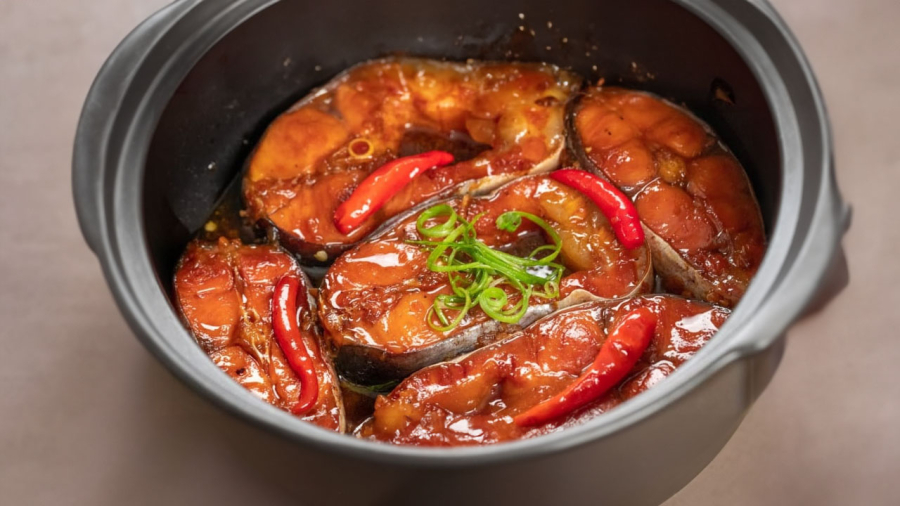Cá kho is an enticing dish in Vietnamese cuisine. Kho nhừ xương is a technique that everyone loves. In the old days, we cooked on wood and straw stoves, so we would just simmer the fish and bury it in the pile of firewood, then the fish would be tender and fragrant. But nowadays we mainly cook on gas or electric stoves, so simmering the fish and bones will be more challenging. However, if you follow this method, the fish will be quickly tender, the pot of fish will not be fishy, and the fish will be flavorful and firm.
Eating kho fish with bones is not only delicious but also nutritionally recommended because eating the bones helps to supplement calcium better. If you use a gas stove or electric pot to simmer the fish, to avoid the bones and fish becoming fishy, you should follow these steps:

Prepare the fish properly
To make kho fish delicious, the fish must be fresh with firm flesh. To prevent the fish from being fishy, you should rinse it with ginger wine, rub salt on it, and remove the black membrane inside the fish. The fish should be cooked immediately after purchase to prevent spoilage. The fish must be fresh, with firm flesh and good elasticity, avoiding fish with scales peeling off, pale color, and cloudy eyes.
To make the kho fish fragrant and delicious, you can use accompanying spices according to the taste of your family:
- Kho fish with soy sauce: the main spices are soy sauce, fish sauce, MSG, lemongrass, and galangal
- Kho fish with pickles: the main spices are pickled mustard greens, fish sauce, and noodles
- Kho fish with green bananas: the main spices are salted fish sauce, noodles, pork belly, green bananas, and green tea leaves
- Kho fish with galangal: the main spices are salted fish sauce, galangal, pork belly, and lemongrass
- Kho fish with dried luffa: use dried luffa, pork belly, fish sauce, and salt
One of the seasonings added to make the simmered fish not fishy and delicious is to use tea (fresh green tea or dried tea), sour tamarind…

To quickly make the fish tender and the bones soft: use boiling water and vinegar (especially important)
To make the fish firm and retain its sweetness, after cleaning the fish, pour boiling water over the fish. Boiling water quickly tightens the outer skin, so it does not release as much amino acid, making the fish firm and less fishy. Moreover, the sweet taste is preserved in the piece of fish, making the simmered fish sweeter.
When adding the fish and spices to the pot, remember to add boiling water instead of cold water. Simmering with cold water causes the fish to become fishy.
To make the fish quickly tender and the bones soft while keeping the meat firm and intact, add lime juice or lime peel. The acidity of lime helps to remove the fishy smell and also helps the fish to quickly soften the bones. This is the secret of traditional cooking. You can line a few slices of lime at the bottom of the pot and add lime juice. On average, for half a kilogram of simmered fish, you can use 1 lime. Using lime is more aromatic than using vinegar.
Tips to create a fragrant aroma for the simmered fish
Green tea leaves, green chili, fresh sugarcane, and lime peel are the spices that help the simmered fish become more fragrant. Besides the main spices such as fish sauce, ginger, galangal, and lemongrass, lining the pot with a few tea leaves or splitting fresh sugarcane, or adding a few slices of green chili… will make the simmering pot of fish very aromatic.
Tea leaves also help the fish meat firm more. Especially when simmering fish with green bananas, galangal, and ginger, adding tea leaves is very suitable.
When simmering fish with soy sauce, line a few slices of sugarcane at the bottom of the pot to enhance the taste and deepen the flavor of the soy sauce simmered fish.
To make the fish more fatty and flavorful, add pork skin to line the bottom of the pot, which not only prevents the pot from burning but also adds a sticky fragrance to the simmered fish. In addition to pork belly, you should add a piece of pork skin so that the pot of simmered fish becomes delicious.

Tips for a beautiful color of simmered fish
Use caramel sauce: Add sugar to the pot, just watch the smell of burnt caramel, not letting the sugar burn, otherwise it will turn black. Amber-colored caramel will give the fish a moderate color. You can add chili powder to adjust the color, or add sesame oil for a beautiful color of the simmered fish.
How to quickly simmer fish and make the bones soft using an electric pot
Step 1: After preparing and cleaning the fish, first layer a layer of auxiliary ingredients at the bottom of the pot: pork skin, tea leaves, galangal, etc. (Depending on the taste you want to simmer, line the corresponding auxiliary ingredient at the bottom of the pot to prevent the fish meat from sticking to the bottom). Place the fish in the pot and arrange the remaining auxiliary ingredients on top. ‘
Step 2: Pour boiling water into the pot of fish. Add the remaining spices and turn on the stove. The water level should cover the fish.
Step 3: Boil the fish in the pot, let it boil for about 5 minutes, then reduce the heat to allow the spices to penetrate deeply into the fish. Let it sit for about 10 minutes, then turn on the pot again and set the timer for 30 minutes to let the water evaporate, then switch the pot to the warm mode. You can occasionally turn on the pot to heat it up again for simmering. Simmer the fish for about 8 hours, then turn it back on and let the water evaporate. At that time, the fish will be tender, the bones will be soft, and the meat will be delicious and fragrant. Simmering the fish in an electric pot allows the fish to gradually cook and the bones to soften without the need to watch over it. While simmering the fish, you can leave the house for 1-2 hours.
The finished product is fragrant fish with meat that is crispy and brown and the fish meat still firm but the bones have softened.
“Tempt Your Taste Buds with These 7 Mouthwatering Snakehead Fish Dishes”
Are you ready to get creative in the kitchen? Asian Seabass, or Cá he, provides a unique flavor and delightful texture that cannot be matched. As this type of fish is part of the grouper family, it has a fatty and fragrant taste to it. All you need to do now is look to the 7 mouthwatering recipes we have for you to try! So, fire up the stove – it’s time to start cooking!




































